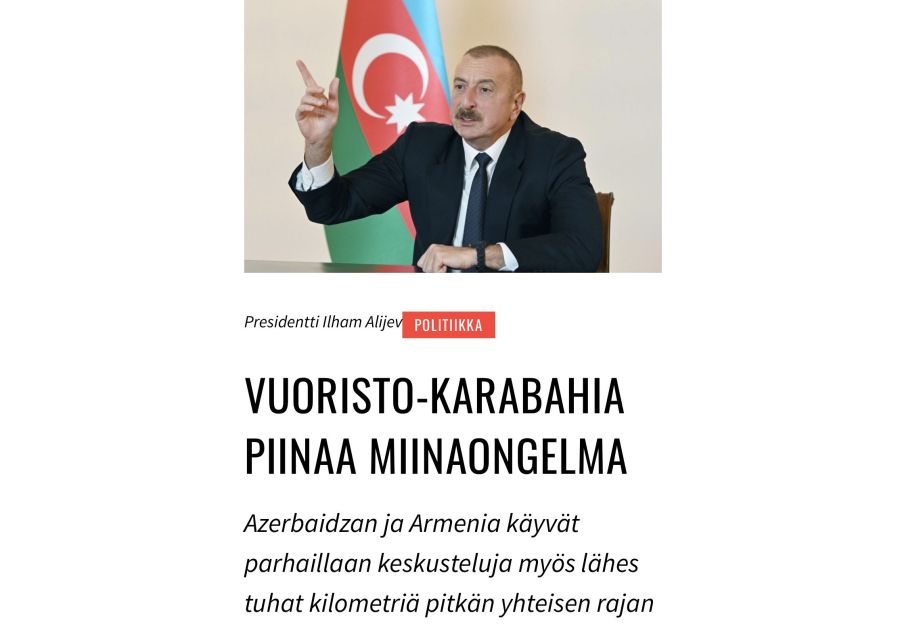Finnish portal publishes article on mine problem in Azerbaijan's liberated territories

An article was published on the Finnish portal, authored by political scientist Jakko Laakson, about the history of the Garabagh conflict, the struggle for the liberation of Azerbaijan's lands, the steps taken towards the normalization of relations between Azerbaijan and Armenia, as well as the mine problems faced by Azerbaijan in the Garabagh region.
The 44-day Patriotic War, known as the world's first unmanned aerial vehicle (UAV) war, ended with a ceasefire mediated by Russia in November 2020, the political scientist said that in September 2023, the occupation of Azerbaijan's territories, which lasted for nearly thirty years, was ended by the Armenian armed forces in Garabagh. said that it ended with his surrender. He emphasized that Turkiye provided great political support to Azerbaijan in the Second Garabagh War.
Citing Azertag, Azernews reports that the article mentions that the biggest problem facing Azerbaijan in the liberated lands is at least 1 million 500 mines and other explosive devices buried in the territories. Azerbaijan uses the experience of many countries to clear land from mines. Noting that our country has so far spent 349 million dollars on mine clearance, the Finnish politician said that Saudi Arabia, the United Arab Emirates, a number of European countries, and the United States also support solving this problem. The author writes that according to the calculations of international experts, about 25 billion dollars will be required to clear the liberated areas of Garabagh from mines.
Reviewing the history of the Karabakh war, Yakko Laakso writes that in the 1990s, Armenian nationalists wanted to join "Nagorno-Karabakh" to Armenia, although legally, Karabakh is a part of Azerbaijan. Noting that no country in the world, including Armenia, recognized the independence of Nagorno-Karabakh during the thirty-year occupation period, the author noted that the so-called Minsk Group was created by the Organization for Security and Cooperation in Europe (OSCE) in 1992 for the peaceful resolution of this conflict. however, he pointed out that the group's activities did not yield any results.
The Finnish politician also noted that nearly 1 million Azerbaijanis became refugees and displaced during the First Garabagh War. The author wrote that after the anti-terrorist operation conducted by Azerbaijan in 2023, ethnic Armenians also voluntarily left the territory of Karabakh. Although the President of Azerbaijan Ilham Aliyev repeatedly emphasized that their rights will be protected and they will live in a tolerant society.
Yakko Laakso spoke about the restoration and construction works in the liberated areas, the return of internally displaced persons to their homes, and the construction of new roads, power plants, and tunnels.
The author draws attention to the fact that Azerbaijan and Armenia are currently working on signing a peace treaty. The other side of Azerbaijan demands to amend the Constitution and give up territorial claims against it.
At the same time, it is mentioned in the article that there are negotiations between Azerbaijan and Armenia regarding the delimitation and demarcation of the borders. He reminded that the Ministry of Foreign Affairs of Armenia declared that the countries have agreed on general principles regarding border demarcation. Yakko Laakso also talked about the Azerbaijani villages whose population was forced to move on the border with Armenia in the early 1990s, and the Armenian opposition's attempt to resist the return of those villages to Azerbaijan.
---
Follow us on Twitter @AzerNewsAz
Here we are to serve you with news right now. It does not cost much, but worth your attention.
Choose to support open, independent, quality journalism and subscribe on a monthly basis.
By subscribing to our online newspaper, you can have full digital access to all news, analysis, and much more.
You can also follow AzerNEWS on Twitter @AzerNewsAz or Facebook @AzerNewsNewspaper
Thank you!
